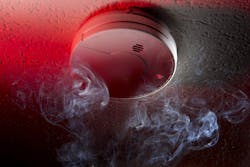Smoke Alarm and Carbon Monoxide Detector Location Requirements
During residential inspections, my biggest challenge is getting electricians and contractors to accept that the “old” way of installing smoke alarms and carbon monoxide (CO) detectors is no longer adequate. This is definitely what I consider a cross-code (or cross-over code) issue. Not only do electricians and builders not know the proper installation requirements for these safety devices, but most inspectors also don’t know as well. I find this troubling as the reference to the primary code for smoke alarms and CO detectors (NFPA 72, National Fire Alarm and Signaling Code) has been referenced in the International Residential Code (IRC) since it was first published in 2000.
Most electricians are familiar with the basic location requirements for these devices. For example, place a smoke alarm in each sleeping room, in areas outside bedrooms, and on each floor of the dwelling, including basements and cellars. They also know smoke alarms shall receive their primary power from the building wiring (with battery back-up) and shall be interconnected in such a manner that the actuation of one alarm will activate all the alarms. But many electricians would struggle to cite additional requirements beyond this basic list.
Let’s take a closer look at the smoke alarm and CO detector requirements outlined in the most current editions of the IRC and NFPA 72.
Placement of devices
Additional requirements
- Smoke alarms shall receive their primary power from the building wiring, with battery back-up. [IRC Sec. 314.6 and NFPA 72, Sec. 29.6.2 (rechargeable batteries) and 29.6.6 (nonrechargeable)]
- When more than one smoke alarm is required they shall be interconnected [IRC Sec. 314.4 and NFPA 72, Sec. 29.8.2.1]. Listed wireless units are allowed. [IRC Sec. 314.4 and NFPA 72, Sec. 29.7.7]
- Where alterations, repairs, or additions requiring a permit occur, the individual dwelling unit shall be equipped with smoke alarms located as required for new dwellings. [IRC Sec. 314.2.2]
As there are many requirements in NFPA 72, this is a synopsis of the very basic requirements. Further requirements exist in the standard for ceilings with beams or joists, sloped or peaked ceilings, and areas exposed to high heat. It’s also important to note the requirements for smoke alarms and carbon monoxide alarms change with each new release of these standards. It is incumbent upon electricians, builders, and inspectors to keep up with these changes — and to accept that NFPA 72 is the real driver as to requirements and placement of smoke alarms/carbon monoxide detectors.
Joseph Alexander, C.B.O., C.F.M, M.C.P., is the chief building official for the City of Suwanee, Ga. He can be reached at [email protected].
About the Author
Joseph Alexander
Joseph Alexander, C.B.O., C.F.M, M.C.P., is the chief building official for the City of Suwanee, Ga. He can be reached at [email protected].
